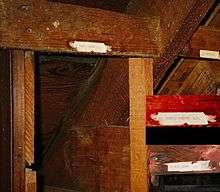Cubby-hole
| Look up cubbyhole in Wiktionary, the free dictionary. |


A cubby-hole, cubby-house or cubby is a small, snug place, which may be considered and used as a place of safety for children.[2] This may be constructed by the children themselves and used as a place of play.[3] Autistic children are especially fond of such places.[4] Children may have a small shed, play-house or tent which they use as a cubby-house.[5] Children might build their own in various places in the house or garden, or have a pre-fabricated cubby. An Australian fictional treatment of the quest for the perfect cubby can be found in Ursula Dubosarsky's "The Cubby House", illustrated by Mitch Vane.[6]
Etymology
Possibly from the term "cub" in old English related to "stall, pen, cattle shed, coop, hutch".[7] "Cubby-hole" is sometimes written as one word (cubbyhole).
Meanings in various countries
In South Africa, cubby-hole is the word for a glove compartment in a vehicle.
This usage is also common in Zimbabwe and Barbados, as well as parts of Southern Minnesota and Northwest Wyoming.
In England and Canada, it may refer to the cupboard under the stairs. In fact, in Quebec, the French word cagibi, which is a contraction of cage à bijoux, and roughly translates as "jewel case", is synonymous with a triangular storage walk-in located directly under the inner stairs of a house.
In the United States, a cubby-hole most often refers to a small square or rectangle-shaped space where children may keep their personal belongings, such as in a preschool or kindergarten setting. These cubby-holes are often constructed out of the same materials as bookshelves and have a similar appearance save for the division of the cubbies themselves.
References
- ↑ Country, Cubbies. "Modern cubby house designs". Retrieved 2012-12-29.
- ↑ "Of the Dorset dialect", Transactions of the Philological Society, B.Blackwell: 51, 1864
- ↑ Karen Stagnitti (2000), Playthings, pp. 25–26, ISBN 978-1-876367-61-9
- ↑ Ellen Notbohm; Veronica Zysk; Temple Grandin (2010), 1001 Great Ideas for Teaching & Raising Children With Autism Or Asperger's, ISBN 978-1-935274-06-3
- ↑ Gwenda Davey; Graham Seal (1993), The Oxford companion to Australian folklore, p. 90
- ↑ The Cubby House: Aussie Nibbles
- ↑ Origin of English word CUBBYHOLE